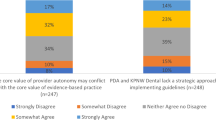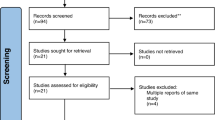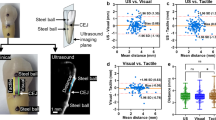Abstract
Introduction Abfraction is a theoretical term used that has been classified as a type of non-carious cervical lesion (NCCL) and characterised by the microstructural loss of hard dental tissue in areas of high stress concentration. There is a lack of consensus among researchers and clinicians as to whether occlusal loading, particularly interferences or eccentric loading, generates sufficient tensile stress to be an aetiological factor in the loss of hard dental tissue at the cemento-enamel junction (CEJ).
Aim This narrative review article assesses the evidence behind the theory of abfraction.
Results It is difficult to control all influencing factors in a clinical trial making it challenging to generate sufficient evidence to conclusively support the theory of abfraction. There is limited evidence occlusal forces are an aetiological agent in non-carious cervical lesion development. However, if occlusal forces do play a role, the term non-carious cervical lesion is more reflective of the limited role it may play and a multifactorial aetiology.
Conclusion The term 'abfraction lesion' remains misleading and could be removed from our diagnostic vocabulary.
Similar content being viewed by others
Log in or create a free account to read this content
Gain free access to this article, as well as selected content from this journal and more on nature.com
or
References
Nascimento M, Dilbone D, Pereira P, Geraldeli S, Delgado A, Duarte W. Abfraction lesions: etiology, diagnosis, and treatment options. Clin Cosmet Investig Dent 2016; 8: 79.
Nascimento M, Gordan V, Qvist V et al. Restoration of noncarious tooth defects by dentists in The Dental Practice-Based Research Network. J Am Dent Assoc 2011; 142: 1368-1375.
Radentz W H, Barnes G P, Cutright E. A survey of factors possibly associated with cervical abrasion of tooth surfaces. J Periodontol 1976; 47: 148-154. DOI: 10.1902/jop.1976.47.3.148.
Lee W C, Eakle W S. Possible role of tensile stress in the aetiology of cervical erosive lesions of teeth. J Prosthet Dent 1984; 52: 374-380. DOI: 10.1016/00223913(84)90448-7.
Lynch C, O'Sullivan V, Dockery P, McGillycuddy C, Sloan A. Hunter-Schreger Band patterns in human tooth enamel. J Anat 2010; 217: 106-115.
McCoy G. The aetiology of gingival erosion. J Oral Implantol 1982; 10: 361-362.
Grippo J. Abfractions: a new classification of hard tissue lesions of teeth. J Esthet Dent 1991; 3: 14-19.
Sarode G, Sarode S. Abfraction: A review. J Oral Maxillofac Pathol 2013; 17: 222-227. DOI: 10.4103/0973-0029X.119788.
Rees J S. The effect of variation in occlusal loading on the development of abfraction lesions: a finite element study. J Oral Rehabil 2002; 29: 188-193. DOI: 10.1046/j.1365-2842.2002.00836.x.
Palamara D, Palamara J E A, Tyas M J, Messer H H. Strain patterns in cervical enamel of teeth subjected to occlusal loading. Dent Mater 2000; 16: 412-419.
Guimarães J C, Guimarães Soella G, Brandão Durand L, Horn F, Narciso Baratieri L, Monteiro S, Belli R. Stress amplifications in dental non-carious cervical lesions. J Biomech 2014; 47: 410-416. DOI: 10.1016/j.jbiomech.2013.11.012.
Michael J A, Townsend G C, Greenwood L A, Kaidonis J. Abfraction: separating fact from fiction. Aust Dent J 2009; 54: 2-8. DOI: 10.1111/j.1834-1837819.2008.01080.x.
Spears I R, Van Noort R, Crompton R H, Cardew G E, Howard I C. The effects of enamel anisotropy on the distribution of stress in a tooth. J Dent Res 1993; 72: 1526-1531.
Xu H H K, Smith D T, Jahanmir S et al. Indentation damage and mechanical properties of human enamel and dentin. J Dent Res 1998; 77: 472-480.
Bartlett D W, Shah P. A critical review of non-carious cervical (wear) lesions and the role of abfraction, erosion, and abrasion. J Dent Res 2006; 85: 306-312.
Dzakovich J J, Oslak R R, In vitro reproduction of noncarious cervical lesions. J Prosthet Dent 2008; 100: 1-10.
Sabrah A H, Turssi C P, Lippert F, Eckert G J, Kelly A B, Hara A T. 3D-Image analysis of the impact of toothpaste abrasivity on the progression of simulated non-carious cervical lesions. J Dent 2018; 73: 14-18. DOI: 10.1016/J.JDENT.2018.03.012.
Turssi C P, Binsaleh F, Lippert F et al. Interplay between toothbrush stiffness and dentifrice abrasivity on the development of non-carious cervical lesions. Clin Oral Investig 2019; 23: 3551-3556.
Waerhaug J. Effect of toothbrushing on subgingival plaque formation. J Periodontol 1981; 52: 30-34. DOI: 10.1902/jop.1981.52.1.30.
Litonjua L A, Bush P J, Andreana S, Tobias T S, Cohen R E. Effects of occlusal load on cervical lesions. J Oral Rehabil 2004; 31: 225-232.
Walter C, Kress E, Gotz H, Taylor K, Willershausen I, Zampelis A. The anatomy of non-carious cervical lesions. Clin Oral Investig 2014; 18: 139-146. doi: 10.1007/s00784-013-0960-0960.
Tsiggos N, Tortopidis D, Hatzikyriakos A, Menexes G. Association between self-reported bruxism activity and occurrence of dental attrition, abfraction, and occlusal pits on natural teeth. J Prosthet Dent 2008; 100: 41-46. DOI: 10.1016/S0022-0023913(08)60135=3.
Ommerborn M A, Schneider C, Giraki M, Schafer R, Singh P, Franz M, Raab W H M. In vivo evaluation of noncarious cervical lesions in sleep bruxism subjects. J Prosthet Dent 2007; 98: 150-158. DOI: 10.1016/S0022-0023913(07)60048-1.
Alvarez-Arenal A, Alvarez-Menendez L, Gonzalez-Gonzalez I, Alvarez-Riesgo J A, Brizuela-Velasco A, deLlanos-Lanchares H. Non-carious cervical lesions and risk factors: a case-control study. J Oral Rehabil 2019; 46: 65-75. DOI: 10.1111/joor.12721.
Pintado M, DeLong R, Ko C, Sakaguchi R, Douglas W. Correlation of noncarious cervical lesion size and occlusal wear in a single adult over a 14-year time span. J Prosthet Dent 2000; 84: 436-443.
Jiang H, Du M Q, Huang W, Peng B, Bian Z, Tai B J. The prevalence of and risk factors for non-carious cervical lesions in adults in Hubei Province, China. Community Dent Health 2011; 28: 22-28.
Bader J, Mcclure F, Scurria M, Shugars D, Heymann H. Case-control study of non-carious cervical lesions, Community Dent Oral Epidemiol 1996; 28: 286-291.
Que K, Guo B, Jia Z, Chen Z, Yang J, Gao P. A cross-sectional study: Non-carious cervical lesions, cervical dentine hypersensitivity and related risk factors. J Oral Rehabil 2013; 40: 24-32. DOI: 10.1111/j.1365-2842.2012.02342.x.
Takehara J, Takano T, Akhter R, Morita M. Correlations of noncarious cervical lesions and occlusal factors determined by using pressure-detecting sheet. J Dent 2008; 36: 774-779. DOI: 10.1016/j.jdent.2008.05.009.
Bartlett D W, Lussi A, West N X, Bouchard P, Sanz M, Bourgeois D. Prevalence of tooth wear on buccal and lingual surfaces and possible risk factors in young European adults. J Dent 2013; 41: 1007-1013. DOI: 10.1016/j.jdent.2013.08.018.
Senna P, Del Bel Cury A, Rösing C. Non-carious cervical lesions and occlusion: A systematic review of clinical studies. J Oral Rehabil 2012; 39: 450-462. doi: 10.1111/j.1365-2842.2012.02290.x.
Silva A G, Martins C C, Zina L G et al. The association between occlusal factors and noncarious cervical lesions: A systematic review. J Dent 2013; 41: 9-16. DOI: 10.1016/j.jdent.2012.10.018.
Kaidonis J A. Tooth wear: the view of the anthropologist. Clin Oral Investig 2008; 12: 21-26. DOI: 10.1007/s00784-007-0154-0158.
Aaron G M. The prevalence of non-carious cervical lesions in modern and ancient american skulls: lack of evidence for an occlusal etiology. University of Florida, Thesis, 2004.
Aubry M, Mafart B, Donat B, Brau J J. Brief communication: Study of noncarious cervical tooth lesions in samples of prehistoric, historic, and modern populations from the South of France. Am J Phys Anthropol 2003; 121: 10-14. DOI: 10.1002/ajpa.10210.
Kieser J A, Dennison K J, Kaidonis J A, Huang D, Herbison P G P, Tayles N G. Patterns of dental wear in the early Maori dentition. Int J Osteoarchaeol 2001; 11: 206-217. DOI: 10.1002/oa.534.
Urzúa I, Cabello R, Rodríguez G, Sánchez J, Faleiros S, Pacheco A. Absence of non-carious cervical lesions (NCCLs) in a Chilean pre-Columbian sample with severe occlusal tooth wear. Int J Odontostomatol 2015; 9: 59-64.
Author information
Authors and Affiliations
Corresponding author
Rights and permissions
About this article
Cite this article
Bhundia, S., Bartlett, D. & O’Toole, S. Non-carious cervical lesions - can terminology influence our clinical assessment?. Br Dent J 227, 985–988 (2019). https://doi.org/10.1038/s41415-019-1004-1
Published:
Issue date:
DOI: https://doi.org/10.1038/s41415-019-1004-1
This article is cited by
-
Analysis of the packing density of Hunter-Schreger bands (HSB): a systematic review and meta-analysis
European Journal of Medical Research (2025)
-
Abfraction Theory: Controversy Analysis, Scoping Review
Current Oral Health Reports (2024)



